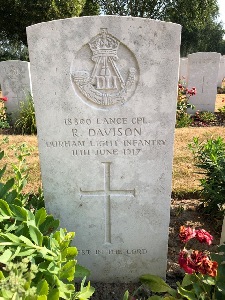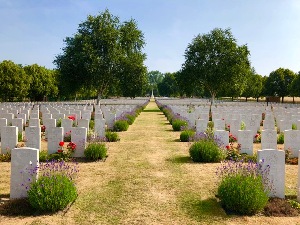
Hooge Crater Cemetery

Hooge Crater Cemetery
Pauline Priano has submitted the following:-
Robert Davison Jnr was the youngest of 6 children, 3 sons and 3 daughters, all of whom survived. His father Robert Davison was born 1838 at Ridsdale, near Hexham, Northumberland and had come with his family to live at Fellside, Marley Hill by 1861 where he was employed as a brick labourer. He married, November 13th 1871 at Whickham, County Durham, to Margaret Cawthorn, native of Armonside, near Ebchester, County Durham, born 1850. Newly married they settled at Marley Hill, where Thomas was born in 1874, James 1876, Ellen 1877 and Margaret Jane 1879. To support his family Robert worked as a labourer at the coke ovens, in 1881 they were living at Milk and Bread House, Marley Hill and had taken in, as a lodger, his brother George Davison (34) a plate layer. Ten years later they were still living at the same address, however their family had grown with the birth of Mary, known as Polly, in 1882 and it would be another ten years before Robert Jnr was born in 1892.Their 2 elder sons had left home by 1901 and Robert Snr was still the only bread winner supporting his wife, 3 daughters and Robert (9). Margaret Davison nee Cawthorn died aged 56 years in 1906, registered in the district of Gateshead. Robert Davison Snr was still living at Milk and Bread House, Marley Hill, in 1911, Robert Jnr (19) had joined him as a labourer at the coke ovens, his elder daughters Ellen (34) and Margaret Jane (32) were still unmarried and living at home.
Britain declared a state war existed with Germany, August 4th 1914, Robert left his employment and enlisted at Stanley, September 8th 1914, assigned to the Durham Light Infantry he joined his regiment at their barracks at Newcastle-upon-Tyne. The new recruits departed from Newcastle, September 23rd for Pirbright, Surrey, where they were divided into 4 new Battalions 10th and 11th Northumberland Fusiliers and the 12th and 13th Battalions Durham Light Infantry at Bullswater Camp. Private 18800 Davison was posted to the 12th Battalion D.L.I. attached to the 68th Brigade, 23rd Division. Training was slow as the men had no uniforms or weapons until October 1914 when they received blue serge uniforms and 100 obsolete Lee Metford rifles. With the onset of winter, the tented camp became unusable, they moved to Malplaquet Barracks, Aldershot, Hampshire in November then to Ashford, Kent, returning to Bramshot in the late spring of 1915. By July 1915 having received uniforms and equipment the division was ready for the front and departed August 26th 1915. The 12th Battalion D.L.I. landed with the division at Boulogne concentrating near Tilques until moving for trench familiarisation to Merris-Vieux Berquin area under the guidance of the 20th and 27th Divisions, September 5th 1915. July 14th they were sent into the front line trenches for the first time between Ferme Grande Flamengrie to the Armentieres-Wez-Macquart road. During the Battle of Loos the 23rd Division held the front at Bois Grenier until they were relieved in January 1916 and sent to the Bruay area for a period of rest returning to front line March 3rd taking over from the French 17th Division the line between Boyan de L’Ersatz and the Souchez River. Several of the men were transferred in March 1916 to the newly formed Tunnelling Company and transferred to the Royal Engineers on loan returning to their unit during April, once again at rest near Bruay returning to the Souchez area before the attack at Vimy Ridge, May 21st 1916.
The infantry moved to Bomy for intensive training June 1916 in preparation for the commencement of the Battles of the Somme. July 7th 1916 the 12th Battalion entered the fighting south of La Boisselle, near Albert, then spent most of August in reserve. October 7th, assisted by a tank they attacked snd captured the Tangle, a complex of trenches and machine guns, east of Le Sars during the Battle of Le Transloy and captured 70 Germans with the loss of only 30 men killed and 80 wounded, they were then withdrawn and sent north to Belgium where they spent the rest of the winter 1916 and spring 1917 in the mud filled trenches of the Ypres salient.
Private Davison had risen to the rank of Lance Corporal by November 16th 1916 and was granted 10 days leave to England as of December 15th 1916 but had still not returned to his unit come January 16th 1917. The Infantry Records Office, York, launched an enquiry as to his whereabouts informing the commanding officer of the 12th Battalion at Durham to search for him. To assist the investigation, they supplied a description of Lance Corporal Davison as, “Eyes-Blue, Hair-Dark brown, Height 5’ 7”, Complexion-Pale clean shaven, Weight-10 stone 7 pounds (approx), Age 25 years 4 months.” The commanding officer of the 12th Battalion received a second letter dated, January 16th 1917, as follows, “With reference to my letter of the 10th inst reporting number 18800 L/Cpl R. Davison absent in England from the 25th Dec. 1916. This N.C.O. has today reported here for duty, having with him a Military Police certificate stating that owning to an outbreak of diphtheria he had been detained. The matter is therefore now in order.” Lance Corporal Davison was drafted back to his regiment in the field January 18th 1916.
The tunnelling companies had been hard at work in the sector not an easy task as the soil in that area was sandy. The explosive filled tunnels were ignited under the German lines June 7th 1917 on the Messines Ridge, the 12th Battalion advanced capturing Impartial trench with the loss of only 15 casualties.
Lance Corporal 18800 Robert Davison was killed in action, June 11th 1917, his body buried by his comrades on the battlefield, his grave marked with a cross bearing his name and military details. After the Armistice at the request of the Belgian and French governments isolated graves and small concentrations were removed and brought into larger cemeteries for reburial. Robert Davison Snr of Milk and Bread House, Marley Hill, had died in the registration district of Gateshead, County Durham in 1918, the letter of explanation was sent to his sister Ellen, now Mrs. Thomas Blackmore, having married, either just prior of after her father’s demise, 1st quarter (Jan/Feb/March) 1918 and reads as follows, “No.1 Infantry Records Office, York, 24th April 1920. Madam, I beg to inform you that it has been necessary to exhume the remains of the late No. 18800, L/Corpl. R. Davison, 12th Battalion, Durham Light Infantry, for proper burial in Hooge Crater Cemetery, 1¾ miles East South East of Ypres. The new grave has been duly marked with a Cross bearing all the late soldier’s details. The removal was undertaken with every measure of care and reverence, and the re-interment conducted by an Army Chaplain. I am, Madam, Your Obedient Servant, for Colonel No.1 Infantry Records.” Lance Corporal 18800 Robert Davison Durham Light Infantry is at rest grave XViII. F. 7. At the time of his demise in 1917 he was 25 years of age and single.
His sister Ellen, as sole and legitimate beneficiary, received all monies due to him, his awards of the 1914-15 Star, British War Medal and Victory Medal. The disc which had enabled the identification of Robert’s remains during the exhumation process was received by her at Fern Dene Cottage, Sunniside, County Durham, July 23rd 1920. She commissioned at a cost of 3 shillings 9 pence an additional inscription to be added to his military headstone, it reads, “Rest In The Lord.”
In God’s safe keeping. Rest In Peace.
Robert Davison is remembered at Marley Hill on M34.01 and M34.06
He is also remembered in The DLI Book of Remembrance page 148

